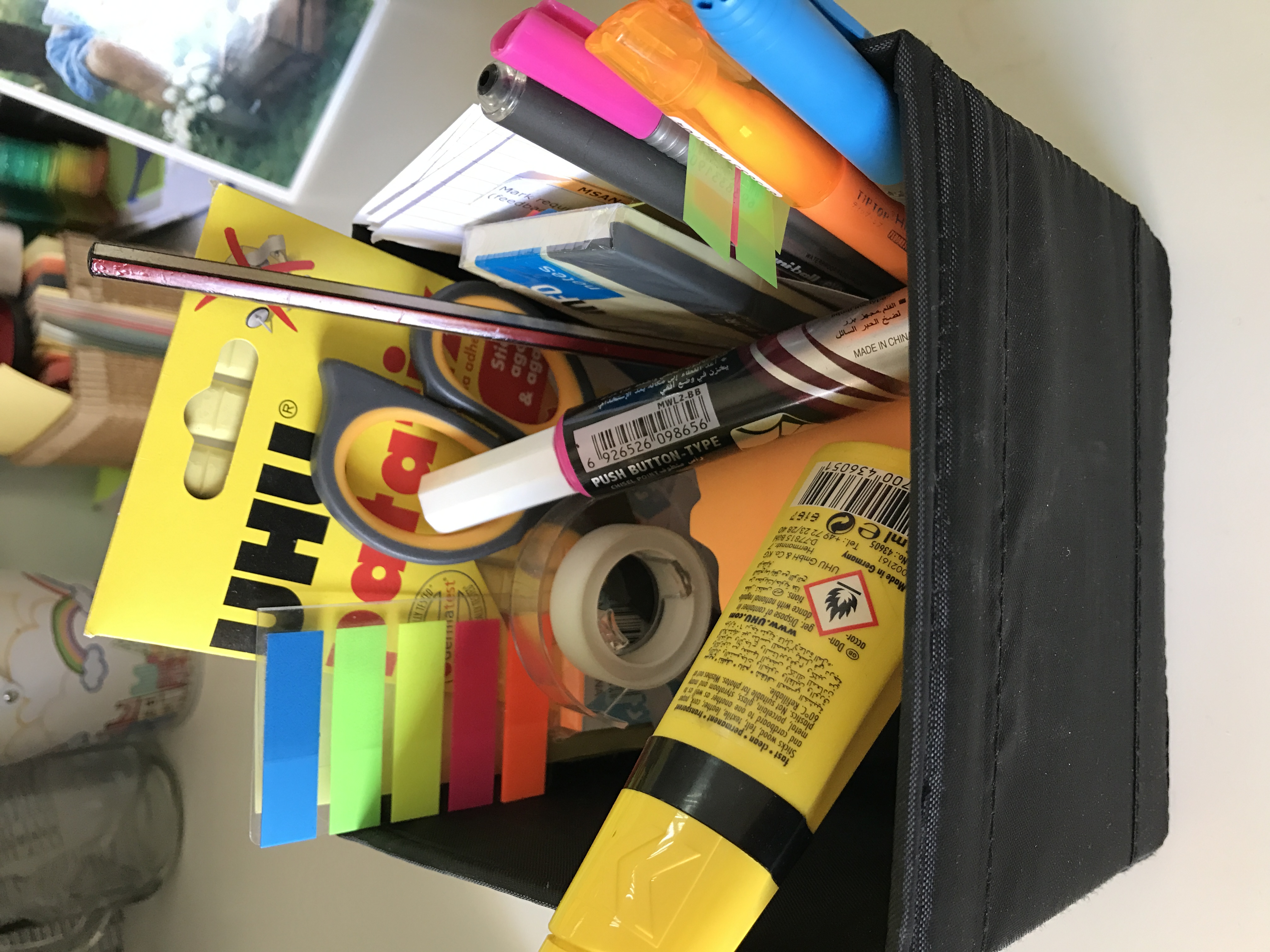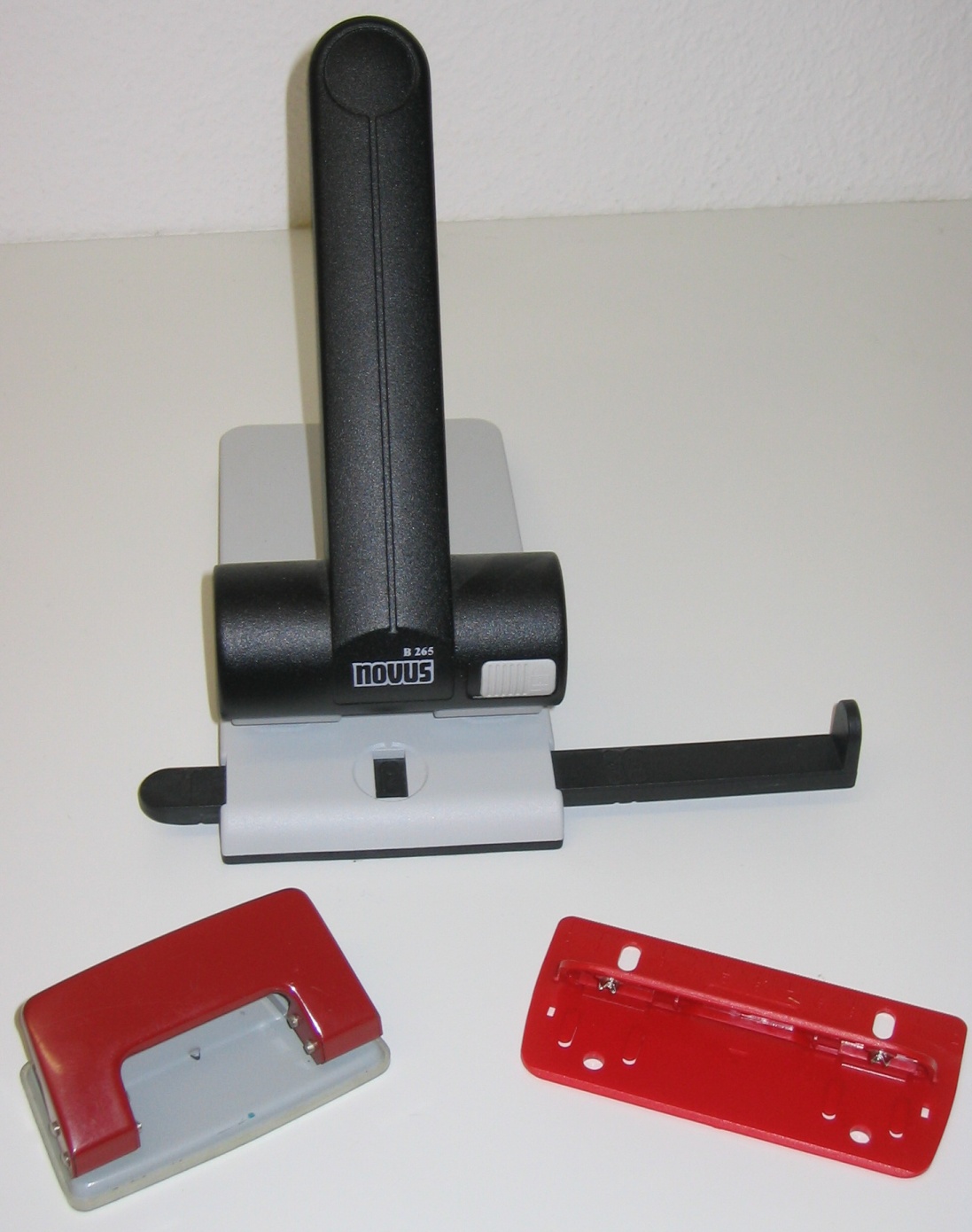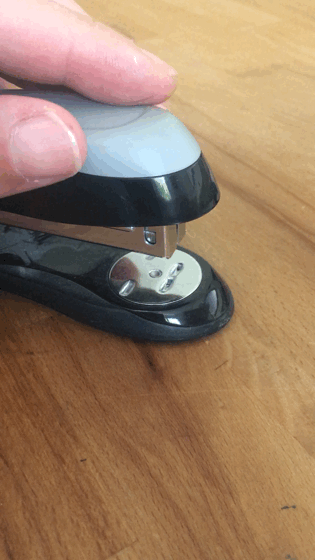|
Brass Fastener
A brass fastener, butterfly clips, brad, paper fastener or split pin is a stationery item used for securing multiple sheets of paper together. A patent of the fastener was issued in 1866 to George W. McGill. The fastener is inserted into punched holes in the stack of paper, and the leaves, or tines, of the legs are separated and bent over to secure the paper. This holds the pin in place and the sheets of paper together. For few sheets of paper, holes can be made using the sharp end of the fastener. A split pin may be used in place of staples, but they are more commonly used in situations where rotation around the joint is desirable. This lends split pins to use in mobile paper and cardboard models, and they are often used as modern scrapbooking embellishments. In the film industry, brass fasteners are an industry standard in binding screenplays. It is shaped somewhat like a nail with a round head and flat, split length. Brass fasteners are made of a soft metal such as brass ... [...More Info...] [...Related Items...] OR: [Wikipedia] [Google] [Baidu] |
Stationery
Stationery refers to writing materials, including cut paper, envelopes, continuous form paper, and other office supplies. Stationery usually specifies materials to be written on by hand (e.g., letter paper) or by equipment such as computer printers. History of stationery Originally, the term 'stationery' referred to all products sold by a stationer, whose name indicated that his book shop was on a fixed spot. This was usually somewhere near a university, and permanent, while medieval trading was mainly carried on by itinerant peddlers (including chapmen, who sold books) and others (such as farmers and craftsmen) at markets and fairs. It was a unique term used between the 13th and 15th centuries in the manuscript culture. Stationers' shops were places where books were bound, copied, and published. These shops often loaned books to nearby university students for a fee. The books were loaned out in sections, allowing students to study or copy them, and the only way to get the ... [...More Info...] [...Related Items...] OR: [Wikipedia] [Google] [Baidu] |
Paper
Paper is a thin sheet material produced by mechanically or chemically processing cellulose fibres derived from wood, Textile, rags, poaceae, grasses, Feces#Other uses, herbivore dung, or other vegetable sources in water. Once the water is drained through a fine mesh leaving the fibre evenly distributed on the surface, it can be pressed and dried. The papermaking process developed in east Asia, probably China, at least as early as 105 Common Era, CE, by the Han Dynasty, Han court eunuch Cai Lun, although the earliest archaeological fragments of paper derive from the 2nd century BCE in China. Although paper was originally made in single sheets by hand, today it is mass-produced on large machines—some making reels 10 metres wide, running at 2,000 metres per minute and up to 600,000 tonnes a year. It is a versatile material with many uses, including printing, painting, graphics, signage, design, packaging, decorating, writing, and Housekeeping, cleaning. It may also be used a ... [...More Info...] [...Related Items...] OR: [Wikipedia] [Google] [Baidu] |
Hole Puncher
A hole punch, also known as a hole puncher or paper puncher, is an office tool that is used to create holes in sheets of paper, often for the purpose of collecting the sheets in a binder or folder (such collected sheets are called loose leaves). A ''hole punch'' can also refer to similar tools for other materials, such as leather, cloth, or sheets of plastic or metal. Mechanism The essential parts of a hole punch are the ''handle'', the ''punch head'', and the ''die''. The punch head is typically a cylinder, with a flat end called the ''face''. The die is a flat plate, with a hole matching the head. The head can move, while the die is fixed in place. Both head and die are usually made of a hard metal, with precise tolerances. One or more sheets of paper are inserted between the head and the die, with the flat face of the head parallel to the surface of the sheets. Moving the handle pushes the head straight through the sheets of paper. The hard edge of the punch vs ... [...More Info...] [...Related Items...] OR: [Wikipedia] [Google] [Baidu] |
Staple (fastener)
A staple is a type of two-pronged fastener, usually metal, used for joining, gathering, or binding materials together. Large staples might be used with a hammer or staple gun for masonry, Roofing material, roofing, corrugated boxes and other heavy-duty uses. Smaller staples are used with a stapler to attach pieces of paper together; such staples are a more permanent and durable fastener for paper documents than the paper clip. Etymology The word "staple" originated in the late thirteenth Century, from Old English ''stapol'', meaning "post, pillar". The word's first usage in the paper-fastening sense is attested from 1895. History In ancient times, the staple had several different functions. Large metal staples dating from the 6th century BC have been found in the masonry works of the Persian empire (ancient Iran). For the construction of the Pasargadae and later Ka'ba-ye Zartosht, these staples, which are known as "dovetail" or "swallowtail" staples, were used for tightenin ... [...More Info...] [...Related Items...] OR: [Wikipedia] [Google] [Baidu] |
Paperboard
Paperboard is a thick paper-based material. While there is no rigid differentiation between paper and paperboard, paperboard is generally thicker (usually over 0.30 mm, 0.012 in, or 12 Inch#Equivalents, points) than paper and has certain superior attributes such as foldability and rigidity. According to International Organization for Standardization, ISO standards, paperboard is a paper with a grammage above 250 g/m2, but there are exceptions. Paperboard can be single- or multi-ply. Paperboard can be easily cut and formed, is lightweight, and because it is strong, is used in packaging. Another end-use is high quality graphic printing, such as book and magazine covers or postcards. Paperboard is also used in fine arts for creating sculptures. Sometimes it is referred to as ''cardboard'', which is a generic, lay term used to refer to any heavy pulp (paper), paper pulp–based board, however this usage is deprecated in the paper, printing, and packaging industries as it does not ade ... [...More Info...] [...Related Items...] OR: [Wikipedia] [Google] [Baidu] |
Scrapbooking
Scrapbooking is a method of preserving, presenting, and arranging personal and family history in the form of a book, box, or card. Typical memorabilia include photographs, printed media, and artwork. Scrapbook albums are often decorated and frequently contain extensive journal entries or written descriptions. Scrapbooking started in the United Kingdom in the nineteenth century. History In the 15th century, commonplace books, popular in England, emerged as a way to compile information that included recipes, quotations, letters, poems, and more. Each commonplace book was unique to its creator's particular interests. Friendship albums became popular in the 16th century. These albums were used much like modern day yearbooks, where friends or patrons would enter their names, titles and short texts or illustrations at the request of the album's owner. These albums were often created as souvenirs of European tours and would contain local memorabilia including coats of arms or works ... [...More Info...] [...Related Items...] OR: [Wikipedia] [Google] [Baidu] |
Screenplay
A screenplay, or script, is a written work produced for a film, television show (also known as a '' teleplay''), or video game by screenwriters (cf. ''stage play''). Screenplays can be original works or adaptations from existing pieces of writing. A screenplay is a form of narration in which the movements, actions, expressions and dialogue of the characters are described in a certain format. Visual or cinematographic cues may be given, as well as scene descriptions and scene changes. History In the early silent era, before the turn of the 20th century, "scripts" for films in the United States were usually a synopsis of a film of around one paragraph and sometimes as short as one sentence.Andrew Kenneth Gay"History of scripting and the screenplay"at Screenplayology: An Online Center for Screenplay Studies. Retrieved 15 December 2021. Shortly thereafter, as films grew in length and complexity, film scenarios (also called "treatments" or "synopses"Steven Maras. ''Screenwri ... [...More Info...] [...Related Items...] OR: [Wikipedia] [Google] [Baidu] |
Metal
A metal () is a material that, when polished or fractured, shows a lustrous appearance, and conducts electrical resistivity and conductivity, electricity and thermal conductivity, heat relatively well. These properties are all associated with having electrons available at the Fermi level, as against nonmetallic materials which do not. Metals are typically ductile (can be drawn into a wire) and malleable (can be shaped via hammering or pressing). A metal may be a chemical element such as iron; an alloy such as stainless steel; or a molecular compound such as polythiazyl, polymeric sulfur nitride. The general science of metals is called metallurgy, a subtopic of materials science; aspects of the electronic and thermal properties are also within the scope of condensed matter physics and solid-state chemistry, it is a multidisciplinary topic. In colloquial use materials such as steel alloys are referred to as metals, while others such as polymers, wood or ceramics are nonmetallic ... [...More Info...] [...Related Items...] OR: [Wikipedia] [Google] [Baidu] |
Brass
Brass is an alloy of copper and zinc, in proportions which can be varied to achieve different colours and mechanical, electrical, acoustic and chemical properties, but copper typically has the larger proportion, generally copper and zinc. In use since prehistoric times, it is a substitutional alloy: atoms of the two constituents may replace each other within the same crystal structure. Brass is similar to bronze, a copper alloy that contains tin instead of zinc. Both bronze and brass may include small proportions of a range of other Chemical element, elements including arsenic, lead, phosphorus, aluminium, manganese and silicon. Historically, the distinction between the two alloys has been less consistent and clear, and increasingly museums use the more general term "list of copper alloys, copper alloy". Brass has long been a popular material for its bright gold-like appearance and is still used for drawer pulls and door handle, doorknobs. It has also been widely used to ma ... [...More Info...] [...Related Items...] OR: [Wikipedia] [Google] [Baidu] |
Split Pin
A split pin, also known as a cotter pin, or cotter key in the United States of America, US, is a metal fastener with two wiktionary:tine, tines that are bent during installation, similar to a staple (fastener), staple or rivet. Typically made of thick wire with a half-circular cross section, split pins come in multiple sizes and types. The British definition of "cotter pin" may include the equivalent to US term "cotter (pin), cotter". To avoid confusion, the term split cotter is sometimes used for a split pin. A further use of the term "cotter pin" is the "crank cotter pin" used to lock bicycle pedal cranks to the bottom bracket axle. These are not "split" at all and are wedge shaped. History The cotter pin was invented by Ira J. Young of the Wire Manufacturing Company in St. Louis, Missouri in 1912. He filed two patents for machines to make the fastener that year. Construction A new split pin (see figure A) has its flat inner surfaces touching for most of its length so that ... [...More Info...] [...Related Items...] OR: [Wikipedia] [Google] [Baidu] |







